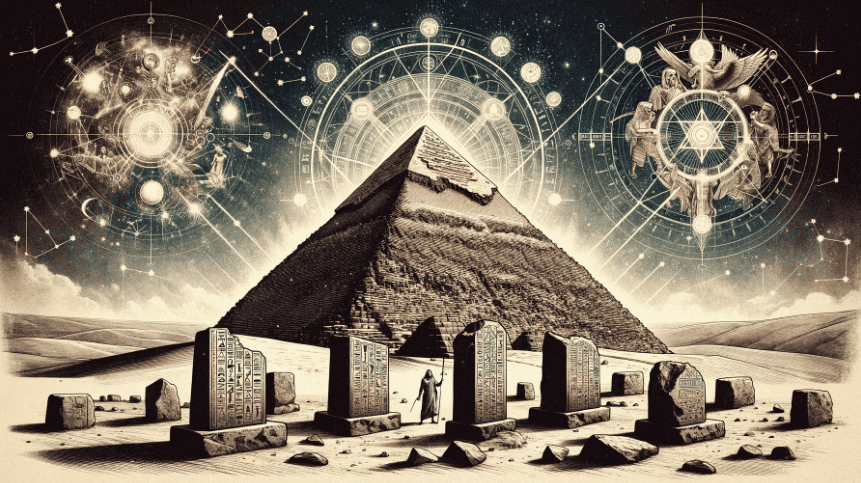Have you ever pondered the mysteries enshrouded within the ancient stones of the Great Pyramid of Giza? What if this architectural marvel holds more than just the secrets of a bygone civilization, but also echoes the profound narratives found in the Bible?
Could the precise alignment with celestial bodies, the absence of hieroglyphs, and the pyramid’s enduring presence be mere coincidences, or do they point to a divine blueprint hidden in plain sight?
This sermon delves into the intriguing parallels between the Great Pyramid and biblical themes, exploring how ancient wisdom and celestial design converge in one of the world’s most enigmatic structures.
Discover the potential prophetic timeline, the symbolic connections, and the profound questions they raise about our understanding of the past, the universe, and the divine.
Is Enoch’s Connection to the Great Pyramid Related to the Pyramid Prophecy?
Enoch’s connection to the pyramid has been a subject of mystery and speculation. Some believe that Enoch, an ancient biblical figure, may have had a role in the construction of the Great Pyramid of Giza. This has led some to question if this connection is related to the Pyramid Prophecy.
Sermon Bulletpoints
1. The Great Pyramid’s construction is a testament to human ingenuity and possibly divine inspiration.
- The pyramid’s precise alignment and construction still baffle experts.
- Some believe its design could reflect biblical truths or prophecies.
- References to structures like the pyramid can be found in the Bible, suggesting a divine connection (Isaiah 19:19-20).
2. The lack of hieroglyphs inside the Great Pyramid sets it apart from other pyramids.
- This absence might indicate a different purpose or origin.
- Biblical parallels are drawn, emphasizing its uniqueness and potential sacredness.
3. The pyramid’s alignment with true north and astronomical precision is remarkable.
- Such precision suggests advanced knowledge or divine guidance.
- The Bible references the heavens declaring God’s glory, which could relate to this astronomical alignment (Psalm 19:1).
4. The pyramid’s size and scale reflect monumental effort and knowledge.
- Its construction required advanced engineering and labor.
- The Bible speaks of God’s power in creation, which can parallel the pyramid’s grandeur (Jeremiah 32:20-21).
5. Enoch’s association with the pyramid highlights a biblical connection.
- Enoch’s righteousness and translation to God are unique in the Bible (Hebrews 11:5).
- The pyramid being called “the pillar of Enoch” suggests a link between his divine favor and the structure.
6. The pyramid’s internal structure and passages might symbolize biblical timelines or events.
- Theorists propose that the passages align with biblical and historical timelines.
- This concept reflects the idea of God’s sovereignty over time (Ecclesiastes 3:1).
7. The pyramid’s “air shafts” and unique internal features differentiate it from typical tombs.
- These features might symbolize spiritual truths or divine breath (Genesis 2:7).
8. The pyramid’s construction techniques surpass human capability, suggesting divine intervention.
- The mortar used is still not understood today, hinting at a higher wisdom.
- This can relate to God’s wisdom being higher than human understanding (Isaiah 55:8-9).
9. The pyramid’s preservation and survival through time showcase its significance.
- Its enduring nature can be seen as a testament to its importance or divine blessing.
- The Bible speaks of God’s eternal nature and everlasting word (1 Peter 1:24-25).
10. The numerical symbolism in the pyramid’s dimensions and features might reflect biblical numerology.
- The use of numbers like 144,000 has direct biblical parallels (Revelation 7:4).
11. The pyramid’s alignment with stars and constellations could reflect biblical signs in the heavens.
- The Bible references celestial signs as part of God’s plan (Genesis 1:14).
12. The pyramid’s foundation and alignment might symbolize Christ as the cornerstone.
- Just as the pyramid’s alignment is crucial to its structure, Christ is foundational to faith (Ephesians 2:20).
13. The possible prophetic timeline within the pyramid echoes biblical prophecy.
- If the pyramid’s passages align with historical and future events, it reflects the biblical view of God’s control over history (Daniel 2:21).
14. The absence of a capstone in the Great Pyramid can symbolize Christ’s rejection and ultimate victory.
- Christ being the rejected stone that becomes the cornerstone is a powerful biblical theme (Psalm 118:22).
15. The pyramid’s potential as a biblical altar in Egypt is fascinating.
- Isaiah 19:19 mentions an altar in Egypt, which some interpret as referencing the Great Pyramid.
16. The precision and knowledge required for the pyramid’s construction point to a superior source of wisdom.
- This mirrors the biblical view of God as the source of all wisdom and knowledge (Proverbs 2:6).
17. The pyramid’s durability and resistance to time can symbolize God’s eternal nature.
- Its longstanding presence echoes biblical themes of God’s unchanging nature (Malachi 3:6).
18. The intersection of the pyramid’s features with significant biblical events highlights divine orchestration.
- As the pyramid aligns with events like the Exodus or Christ’s crucifixion, it suggests a divine narrative (Galatians 4:4).
19. The transformation from skepticism to belief by researchers mirrors biblical conversions.
- As the engineer turned from skepticism to faith, it reflects biblical themes of revelation and understanding (Acts 9:1-19).
20. The pyramid as a potential divine sign in Egypt aligns with biblical themes of God revealing Himself to nations.
- God’s promise to reveal Himself to Egypt and heal it can be paralleled with the pyramid’s significance (Isaiah 19:21-22).
Affiliate Disclosure: "As an Amazon Associate I earn from qualifying purchases made from links in this post. We are a participant in the Amazon Services LLC Associates Program, an affiliate advertising program designed to provide a means for us to earn fees by linking to Amazon.com."

